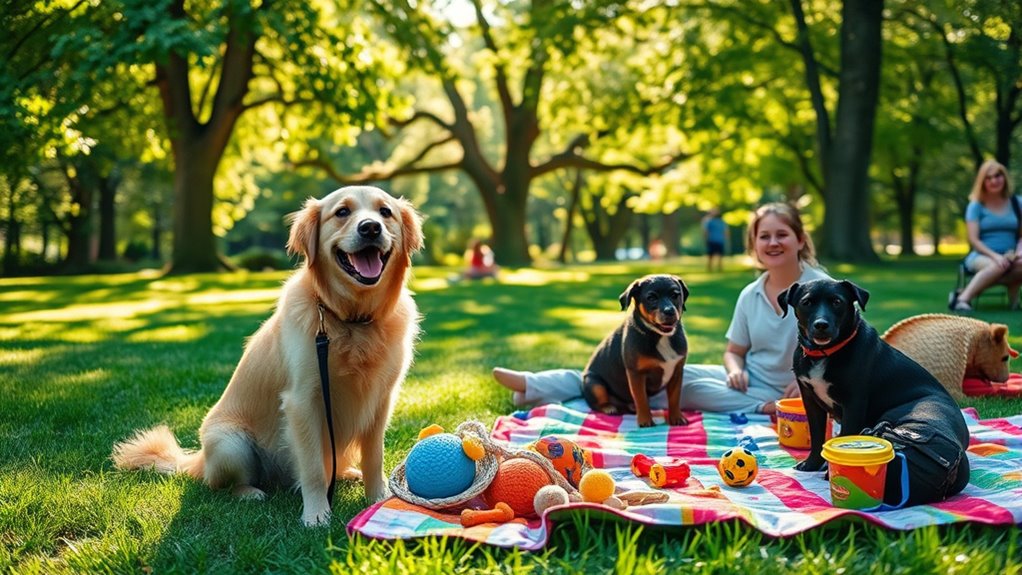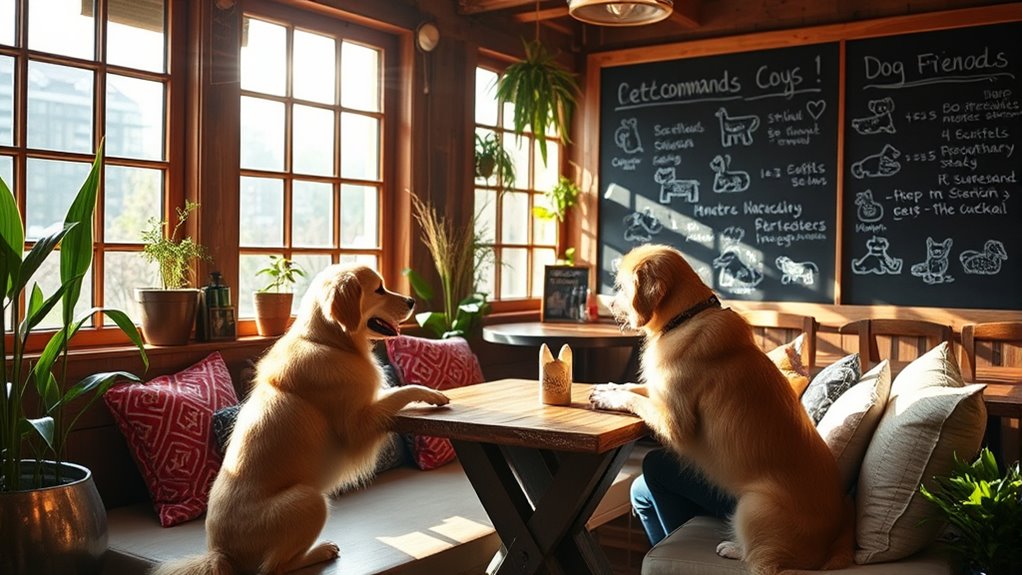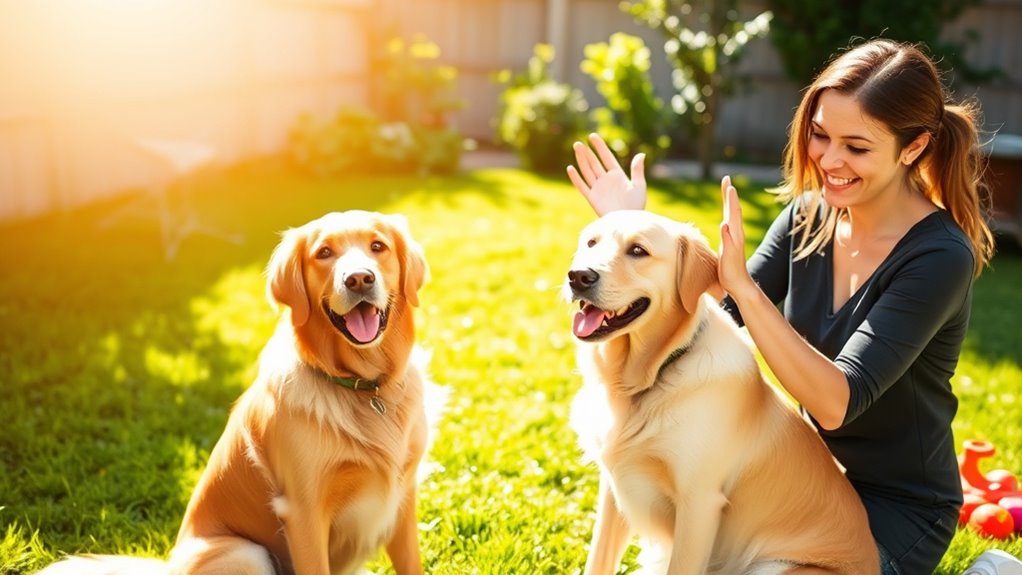To teach your dog sign language commands, start by using high-value treats like cheese or chicken jerky to capture their attention. Choose simple, distinctive hand signals that you use consistently to avoid confusion. Reinforce learning with immediate rewards when they respond correctly. Keep practice sessions short and include interactive activities to keep your dog engaged. This method not only improves communication but also strengthens your bond. Explore more techniques to enhance your training experience!
Key Takeaways
- Use high-value gourmet treats to create positive associations with sign language commands during training sessions.
- Keep training sessions short and consistent, practicing cues throughout the day for better retention.
- Choose simple, distinctive signs to reduce confusion and ensure your dog can easily recognize them.
- Utilize immediate rewards after your dog responds correctly to reinforce learning and strengthen the bond.
- Incorporate visual cues and maintain consistency in commands for effective communication, especially in noisy environments.
Sign Language Basics for Dogs

When teaching your dog sign language, using gourmet dog treats can greatly enhance the learning process. These tasty rewards not only motivate your pup but also create a positive association with the signs you’re teaching. Hand signals can significantly improve communication between you and your dog, making training more effective and enjoyable. Regular outings to puppy training classes can provide valuable opportunities for socialization and reinforce the sign language commands in a structured environment. Incorporating positive reinforcement techniques can further enhance your dog’s learning experience and strengthen your bond. Additionally, ensuring your dog receives regular veterinary check-ups can help maintain their overall health, making them more receptive to learning new commands. Dogs benefit from early socialization as it prepares them to interact positively with various environments and situations.
Gourmet Dog Treats Unveiled
While teaching your dog sign language commands, incorporating gourmet dog treats can make the process even more enjoyable and effective. Healthy and tasty treats not only motivate your furry friend but also strengthen your bond. Here’s a simple guide to help you choose the right treats:
| Treat Type | Benefits |
|---|---|
| Cheese Cubes | High-value, easy to handle |
| Bully Sticks | Long-lasting, engaging |
| Chicken Jerky | Tasty and nutritious |
| Freeze-Dried Liver | Rich in protein |
| Veggie Crunchies | Healthy and low-calorie |
Using a treat pouch allows for quick rewards. Remember, timing is vital—reward immediately after your dog responds to a command. Keeping a personal budget for dog treats can help manage your spending while ensuring your dog gets the best. Keep it fun, and don’t forget to vary the treats! Additionally, using hand signals during training enhances communication with your dog, making it easier for them to understand commands. The use of high-value treats can significantly improve your dog’s responsiveness and eagerness to learn. Be cautious about the treats you select, as some foods, like grapes, are toxic to dogs and should always be avoided.
Popular Destinations for Pets

When planning your next getaway, consider pet-friendly urban centers that cater to both you and your furry friend. Many cities offer secret parks and trails perfect for exploring together, providing a rejuvenating escape from the hustle and bustle. Dog-friendly museums are also available in some locations, allowing you to enjoy culture while spending time with your pet. Additionally, visiting dog-friendly attractions can enhance your travel experience by providing various activities that both you and your dog will enjoy. It’s essential to choose destinations that prioritize pet wellness to ensure a safe and enjoyable trip for your furry companion. Many of these cities are also embracing sustainable fashion practices, ensuring that your travels leave a minimal environmental footprint. Always check for common health concerns specific to your dog’s breed when traveling to new environments. Don’t forget to bring high-value treats to reward your dog for their good behavior while you enjoy your adventures!
Pet-Friendly Urban Centers
As you explore urban centers that welcome pets with open arms, you’ll discover a variety of destinations designed to enhance your furry friend’s experience. Cities like St. Petersburg and Tucson boast numerous dog parks and pet-friendly restaurants, ensuring your pup can enjoy both playtime and dining out with you. Portland stands out for its excellent infrastructure, offering plenty of pet stores and vet offices. With safe sleep environments for pets in mind, these cities attract residents and businesses, fostering community engagement and economic growth. The number of dog parks per capita also plays a significant role in creating vibrant environments for pets and their owners. Additionally, cities like Kansas City celebrate community engagement through events that can include pet-friendly activities, leading to higher adoption rates and better animal welfare. Many of these urban areas also prioritize community engagement by hosting festivals and events that cater to pet owners and their furry companions. For instance, Fort Worth, Texas, is known for its vibrant community events that often include cultural celebrations highlighting local heritage, creating an inviting atmosphere for pets and their owners.
Secret Parks and Trails
Many pet owners are unaware of the hidden gems that lie within their urban surroundings. Secret parks and trails can offer you and your furry friend peaceful escapes from the hustle and bustle.
Here are a few popular destinations you should explore:
- Kletzsch Park: Enjoy serene trails and a stunning waterfall along the Milwaukee River Parkway. Emotional stability is essential for both you and your pet during your adventures. Engaging in outdoor activities can also foster social interactions between you and your dog. Additionally, spending time in nature can significantly improve your mental well-being.
- Havenwoods State Park: With over 6 miles of trails through diverse landscapes, it’s perfect for leashed dogs. Dogs must be leashed at all times to ensure everyone’s safety.
- Bay View Park: Ideal for water-loving dogs, this park provides beach access to Lake Michigan.
These locations not only enhance your dog’s adventures but also allow you to enjoy the beauty of nature right in your city.
Discovering these spots can transform your walks into exciting explorations!
Use High-Value Treats
High-value treats can make a significant difference in your dog’s training experience, especially when teaching them sign language commands.
These treats, like beef jerky, chicken strips, or cheese cubes, are foods your dog loves but rarely receives. They tend to prefer meaty flavors, so offering treats with a strong smell and appealing texture can capture their attention during training. High value treats serve as powerful reinforcement tools that encourage good behavior and obedience. Additionally, using positive reinforcement techniques can further enhance your dog’s ability to learn and respond to commands. It’s important to note that consistency in training is crucial, just as it is with chicken ownership considerations for social behavior. Using necessary cookies can also help track training progress effectively. Furthermore, incorporating high-fiber foods into your dog’s diet can support their overall health and energy levels. Use these treats as positive reinforcement when your dog successfully responds to a command. Start with the lure method, placing a treat in your hand to guide them into the desired position.
Remember to phase out treats gradually as your dog learns. Consistent use of high-value treats will motivate your dog and enhance their learning experience.
Pet-Friendly Cafés

If you love spending time with your dog at a café, you’re in for a treat! Many pet-friendly cafés now offer dog-friendly menus, regional wine tastings, and even culinary classes for dogs. These experiences not only make your outing enjoyable but also help strengthen the bond between you and your furry friend. With the significant growth of pet-friendly cafés across China, you can find more options than ever to enjoy quality time with your pet.
Dog-Friendly Menu Highlights
Dog-friendly cafés offer a delightful dining experience for both you and your furry companion.
These establishments not only welcome pets but also provide a variety of delicious menu options that cater to both human and canine tastes. You’ll find a vibrant atmosphere that makes your outing enjoyable.
Here are some highlights to look out for:
- Global Cuisine: Enjoy dishes inspired by flavors from around the world at Gypsy Cafe.
- Breakfast Favorites: Savor the renowned pancakes at Polly’s Pancake Parlor.
- Dog Menus: Some cafés even offer special menus just for your pup, such as those found at Black Mtn Burger Co. which features a pet-friendly patio.
With outdoor seating, friendly staff, and positive customer reviews, dog-friendly cafés create the perfect setting for a memorable meal with your four-legged friend.
Regional Wine Tastings Available
As you explore the world of regional wine tastings, you’ll discover a variety of pet-friendly wineries that welcome you and your leashed dog. For instance, SoLu Estate Winery & Meadery in Wisconsin invites you to enjoy their wines alongside your furry friend. In Oregon’s Willamette Valley, numerous dog-friendly wineries offer guides to nearby pet-friendly lodging, ensuring a seamless experience. Illinois boasts options like Miss Kitty’s Grape Escape and Tuscan Hills Winery, where you can sip wine while your dog relaxes by your side. Many of these venues provide outdoor seating, perfect for enjoying the scenery together. Just remember to check pet policies beforehand, and consider booking accommodations in advance to secure your spot! Additionally, having your dog trained in hand signals can enhance communication during your visit, making the experience more enjoyable for both of you.
Culinary Classes for Dogs
After enjoying a delightful wine tasting with your furry companion, you might want to explore culinary experiences that cater to dogs as well. Pet-friendly cafés are popping up everywhere, offering unique menus designed just for your pooch. Here are a few highlights you won’t want to miss:
- Shake Shack: Treat your dog to a Pooch-ini or Bag O’ Bones at their outdoor seating.
- Tin Shed Garden Café: Indulge your pup with organic meals like Fido Food and Doggie Dessert.
- Lazy Dog Restaurants: Satisfy your dog’s taste buds with chicken, veggies, or a grilled burger patty. Many establishments offer specialized dog menus, which makes it easier than ever to enjoy a dining experience with your pet.
These culinary classes not only enhance your dog’s palate but also create a fun bonding experience for both of you!
Must-See Sights
When you’re out exploring with your dog, there are some must-see sights that can enhance your training experience. Historic monuments and breathtaking mountain landscapes provide the perfect backdrop while you practice sign language commands. Plus, interactive dog agility courses let you reinforce visual cues in an exciting environment. Incorporating consistent sign cues during these outings will further solidify your dog’s understanding of commands.
Historic Monuments and Statues
Historic monuments and statues are more than just structures; they embody the cultural and historical essence of a place.
Visiting these iconic sites can deepen your understanding of the world around you. Here are some must-see monuments and statues:
- Statue of Liberty: A powerful symbol of freedom and democracy in New York Harbor. Gifted by France, it stands as a testament to the enduring values of liberty.
- Christ the Redeemer: This towering statue in Rio de Janeiro offers stunning views and represents faith.
- Great Sphinx of Giza: An ancient marvel that captures the mysteries of Egyptian civilization.
Each of these statues tells a story, connecting you to the past while enriching your travels.
Breathtaking Mountain Landscapes
Mountains have a way of enchanting the soul, drawing travelers into their awe-inspiring beauty and grandeur. Whether you’re hiking in the majestic Himalayas or gazing at the stunning Matterhorn, these landscapes offer unforgettable experiences. Here’s a glimpse of some must-see mountain destinations:
| Location | Highlights | Unique Features |
|---|---|---|
| Devil’s Tower, USA | Unique rock formation | First U.S. national monument |
| Royal Natal National Park, SA | Natural amphitheater | Impressive mountain scenery |
| Aoraki National Park, NZ | Tasman Glacier | Home to New Zealand’s highest peak |
| Huangshan Mountains, China | Granite rock formations | UNESCO World Heritage Site |
| Banff National Park, Canada | Glaciers and ice fields | Stunning Canadian Rockies |
These breathtaking sights await your exploration! Additionally, the unique landscapes of Banff National Park are vulnerable to climate-related shifts, highlighting the importance of preserving these natural wonders.
Interactive Dog Agility Courses
Interactive dog agility courses offer an exciting way to bond with your furry friend while honing their skills.
These courses provide a fun environment for both you and your dog, enhancing their agility and obedience. You can choose from online courses or indoor agility kits, making it convenient to train at home or in a park.
- Spot On Agility: Enjoy a 21-day online course with no equipment needed.
- Outward Hound Kit: Set up various obstacles indoors with collapsible tunnels and adjustable jumps.
- Expert Guidance: Access personalized coaching and video reviews for effective training. Additionally, you can accelerate your training with flexible options that fit your schedule.
Embrace these interactive courses to keep your dog engaged, fit, and ready to learn new commands together!
Use Visual Cues Consistently
When training your dog, using visual cues consistently can considerably enhance their understanding and responsiveness. Start by incorporating high-value treats to capture attention and pair them with hand signals, like “sit” or “stay.” This combination reinforces learning as dogs respond better to visual cues than verbal ones. Eye contact is essential for building a stronger bond between you and your dog, so make sure to engage their gaze during training sessions.
Establish a routine that includes practicing these cues throughout the day, so your dog can learn in various contexts. Use visual markers, like a thumbs-up, to provide immediate feedback and positive reinforcement.
For deaf dogs, incorporate American Sign Language (ASL) to guarantee clear communication. Remember, consistency is key; using the same signals helps reduce confusion and strengthens your dog’s ability to respond to commands effectively.
Practical Tips

When you’re ready to start teaching your dog sign language, consider practical tips to make the process smoother. Think about how you’ll get to your training location, the best times for practice, and where you might stay if you plan to train away from home. Consistency is key for successful training, so try to incorporate short training sessions into your daily routine.
Getting There
Getting started with teaching your dog sign language commands can be an exciting journey. To make the process smoother, here are some practical tips to keep in mind:
- Choose Simple Signs: Use clear and distinctive signs that your dog can easily recognize.
- Be Consistent: Stick to the same signs to avoid confusing your pup during training.
- Reward Success: Implement a reward system to reinforce correct responses every time. Visual cues are particularly effective for dogs, as they learn better visually than verbally.
Training in a quiet area helps maintain focus, and using treats to lure your dog into positions can be very effective.
Don’t forget to practice regularly to keep their skills sharp. With patience and consistency, you’ll see your dog thriving in understanding sign language commands!
Getting Around
To navigate the process of teaching your dog sign language commands effectively, you’ll want to create a supportive environment that fosters learning.
Start with simple, distinctive signs, using one hand for practicality. Choose signs that are easy to distinguish, and be consistent in your usage. When your dog responds correctly, reward them immediately to reinforce the behavior.
Begin with a “watch me” cue to encourage eye contact, and use treats to guide them into positions. Regular training sessions are essential for retention. Incorporate visual markers like a thumbs up to signify correct actions. Dogs respond to facial expressions and body language, so use your own expressions to help convey the meaning of the commands.
If challenges arise, adjust your movements and maintain patience, especially with deaf or hearing-impaired dogs. Consistency and positive reinforcement are your best tools for success.
Best Time to Visit
Training your dog to understand sign language commands requires consistency and patience, but once your pup is responding well, it’s time to think about the best time to visit various destinations.
Consider the following tips to enhance your travel experience:
- Weather Conditions: Spring and autumn provide the best outdoor activities, avoiding extreme temperatures.
- Tourist Season: Visiting during the off-season can mean fewer crowds and lower prices, while peak seasons can lead to high accommodation costs and busy attractions.
- Cultural Events: Check local calendars for festivals or events; these can offer unique experiences but may affect availability and pricing. Incorporating hand signals into your dog’s training can also help improve communication during your travels.
Planning around these factors can make your travels more enjoyable for both you and your furry friend!
Where to Stay
When planning where to stay during your trip with your dog, it’s important to prioritize pet-friendly accommodations that cater to both your and your furry friend’s needs. Look for locations near dog-friendly parks and trails for easy access to outdoor activities. Always check the pet policy to verify dogs are allowed and inquire about specific rules. Choose a space that has enough room for your dog to move comfortably. Daily practice of commands can help your dog adjust better to new environments and routines during your stay. Amenities like dog beds or pet-sitting services can enhance your stay. Before booking, read reviews from other pet owners to gauge suitability. Finally, book in advance, especially during peak seasons, to secure the best options for you and your pup.
Local Etiquette
Finding the right place to stay with your dog sets the stage for a positive experience, but understanding local etiquette is just as important.
When you’re out in public, you want to guarantee your dog is well-behaved and that you communicate effectively. Here are some practical tips:
- Use clear hand signals for commands like “stay” and “come” to maintain control in noisy areas.
- Engage with your community by teaching your dog ASL-inspired signs, fostering inclusive interactions. Additionally, providing communication for deaf dogs can significantly enhance your dog’s ability to respond to commands in various environments.
- Educate others about the benefits of sign language for dogs, promoting awareness and understanding.
Pro Tip
To effectively teach your dog sign language commands, focus on visual learning, as dogs respond better to visual cues than to verbal ones.
Consistency is key; use the same hand signals each time to help your dog learn. Combine positive reinforcement with treats and praise to encourage desired behaviors. Gradually phase out verbal cues as your dog becomes familiar with hand signals.
Remember, patience is essential—training takes time. Start with basic commands like “sit” and “stay,” using distinct signals for each. Regular practice in daily routines helps solidify understanding.
For better communication, consider incorporating resources like ASL dictionaries or online videos. Engaging with communities can also provide valuable support and tips along the way.
Frequently Asked Questions
Can All Dog Breeds Learn Sign Language Commands?
Absolutely, all dog breeds can learn sign language commands!
It doesn’t matter if your pup is big or small; they’re all capable of understanding visual cues. Since dogs naturally communicate through sight, you’ll find that using hand signals can enhance your connection.
Whether you’ve got a lively puppy or a wise old dog, they can both benefit from learning these commands.
How Long Does It Take to Teach a Dog Sign Language?
Teaching your dog sign language is like planting a seed; it takes time and care to grow.
Generally, it can take a few weeks to several months, depending on your dog’s age, health, and the complexity of the signs.
Consistency and regular practice are key—like watering that seed daily.
With patience and positive reinforcement, you’ll see that little sprout flourish into a well-communicating companion, ready to respond to your gestures.
What Age Should I Start Teaching My Dog Sign Language?
You can start teaching your dog sign language at any age, but beginning early is best.
Puppies are particularly receptive and can grasp basic signs when they’re old enough to focus.
However, senior dogs and even hearing dogs can benefit from sign language, especially if they face distractions or hearing loss.
The key is to maintain consistency and patience throughout the training process, regardless of your dog’s age.
Are There Specific Signs for Different Commands?
Yes, there are specific signs for different commands.
For example, to signal “sit,” raise your hand with your palm up above your dog’s head and move it backward.
To indicate “down,” sweep your hand with the palm down toward the ground.
For “stay,” hold your palm out like a stop sign.
Each sign helps your dog understand what you want, making communication clearer and more effective.
Consistency is key, so use the same signs every time.
How Do I Reinforce Learning During Sign Language Training?
Reinforcing learning during sign language training isn’t just about repetition; it’s about making connections.
You’ll want to reward immediately after marking the correct behavior, creating a strong link in your dog’s mind. Mix up rewards to keep things exciting, and use positive reinforcement to build trust.
Consistency is key, so provide clear feedback and practice in various settings. Gradually increase distractions, challenging your dog while ensuring they feel supported throughout the process.
Conclusion
Incorporating sign language commands into your dog’s training can be like opening a new door to communication. By teaching your furry friend these basics, you’ll strengthen your bond and enhance their understanding. Remember to practice consistently and be patient; just like nurturing a garden, it takes time for growth. So, embrace the journey, celebrate the small victories, and enjoy the unique connection you’ll create through this silent yet powerful language. Your dog will thank you with every wag!











